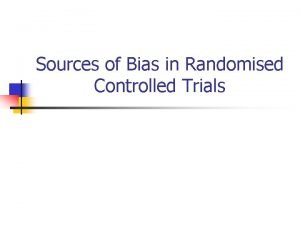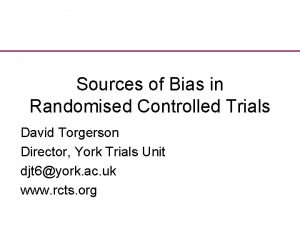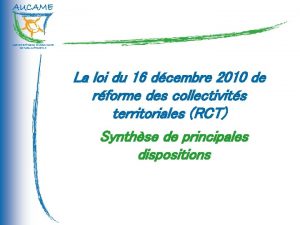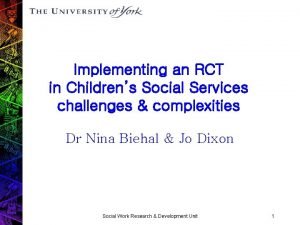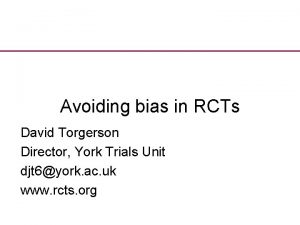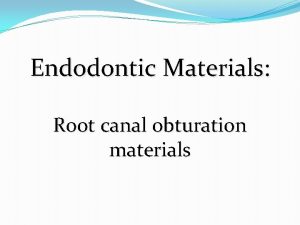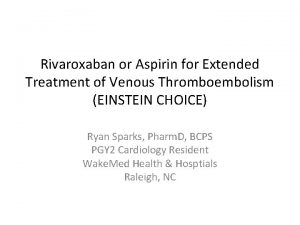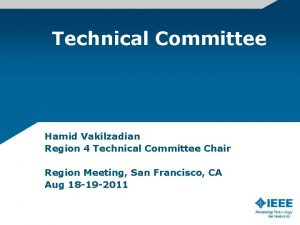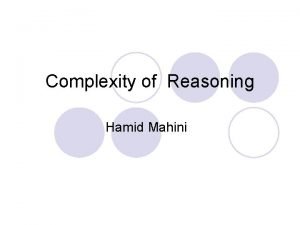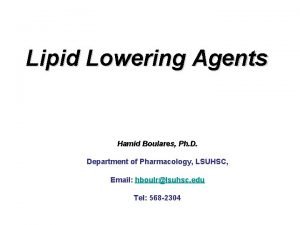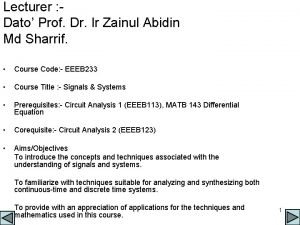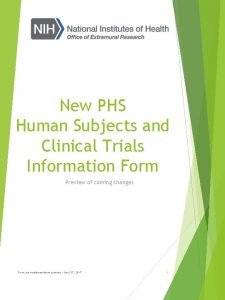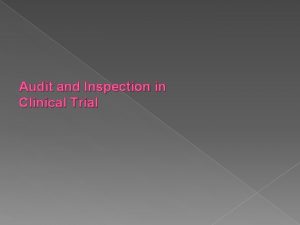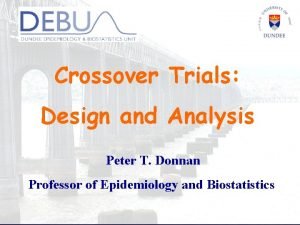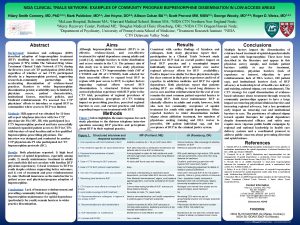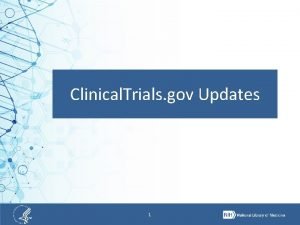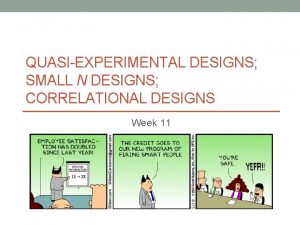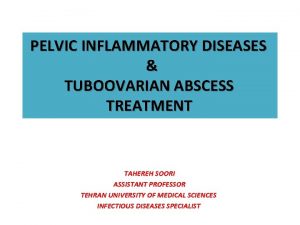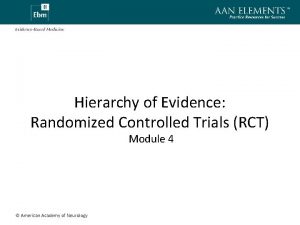RCT DESIGNS FIELD AND COMMUNITY TRIALS Hamid Soori






















































- Slides: 54

ﺍﻧﻮﺍﻉ ﻃﺮﺍﺣی ﻫﺎ ﺩﺭ کﺎﺭآﺰﻣﺎیی ﻫﺎی ﺑﺎﻟیﻨی کﺎﺭآﺰﻣﺎﻳی ﺩﺭ ﻋﺮﺻﻪ ﻭ ﺩﺭ ﺟﺎﻣﻌﻪ RCT DESIGNS FIELD AND COMMUNITY TRIALS Hamid Soori Professor of Epidemiology Dept. of Epidemiology, School of Public Health Shahid Beheshti University of Medical Sciences


DESIGN The choice of design depends on the goal of the trial Choice also depends on the population, knowledge of the intervention Proper design is critical, analysis cannot rescue improper design 3



CROSSOVER DESIGN (PLANNED & UNPLANNED CROSSOVER TRIAL) A: DESIGN OF A PLANNED CROSSOVER TRIAL 6


B: DESIGN OF A UNPLANNED CROSSOVER TRIAL Randomized Surgical Care Refuse Surgery Medical Care Require Surgery No Surgery 8

CROSS-OVER DESIGN: ﻃﺮﺍﺣﻲ ﻣﺘﻘﺎﻃﻊ Advantage Each patient their own control Smaller sample size Disadvantage Not useful for acute disease Disease must be stable Assumes no period carry over If carryover, have a study half sized (Period I A vs. Period I B) 9


Fractional Design 11


FACTORIAL DESIGN Advantages Two studies for one Discover interactions Disadvantages Test of main effect assumes no interaction Often inadequate power to test for interaction Compliance 13




SEQUENTIAL DESIGN Continue to randomize subjects until H 0 is either rejected or “accepted” A large statistical literature for classical sequential designs Developed for industrial setting Assumptions Acute Response Paired Subjects Continuous Testing Not widely used 17





Run-In Design Screen & Consent R A Run-In Satisfactory N Period D O M I Unsatisfactory Z E A B Dropped Note: It is assumed that all patient entering the run-in period are eligible and have given consent 22

WITHDRAWAL STUDY I Trt A Treatment A II Not Trt A H 0: How long should TRT A continue? Advantage Easy Access to Subjects Show continued treatment Beneficial Disadvantage Selected Population Different Disease Stage 23

PHASES OF CLINICAL TRIALS Phase Zero trials- Pre-human animal and laboratory testing Phase I trials Phase III trials Phase IV trials Meta-analysis—phase 4 Retrospective cohort studies—phase 4 Case–control studies—phase 4 24

PHASE 0 - PRECLINICAL Pre-clinical (in vitro) animal studies Looking for dose-response Phase 0 trials serves as a good tool for clinical researchers in testing the safety and efficacy of drugs at micro level before the onset of phase I trial. By design, phase 0 trials threaten lower risks to human subject than traditional phase I trials. As such, fewer preclinical supporting data are required prior to conducting a phase 0 trial. The initial agent dose depends in part on the stated trial objectives, but should not be greater than 1/50 th of the no-observed-adverse-effect level (NOAEL) estimated from animal toxicology testing. 25

LIMITATIONS OF PRE-HUMAN ANIMAL AND LABORATORY TESTING High dose effects may not correlate with effects on humans Species differences may result in missing effects that later appear in human testing or after widespread clinical use 26

Continuum of increasing evidence Long term Definitive randomized implementation controlled trial Exploratory trial Modelling Theory Explore relevant theory to ensure best choice of intervention and hypothesis and to predict major confounders and strategic design issues Preclinical Identify the components of the intervention and underlying mechanisms by which they will influence outcomes to provide evidence that you can predict they relate to and interact with each other Phase I Describe the constant and variable components of a replicable intervention and a feasible protocol for comparing the intervention with an appropriate alternative Phase II Compare a fully defined intervention with an appropriate alternative using a protocol that is theoretically defensible, reproducible and adequately controlled in a study with appropriate statistical power Phase III Determine whether others can reliably replicate your intervention and results in uncontrolled setting over the long term Phase IV 27

PHASE I TRIALS (FIRST IN HUMAN PHASE) • • • First time testing on human In a small group of 20 -80 cases Patients usually failed other alternatives Sometimes called dose-finding or dose-escalation studies Seeking maximum tolerated dose (MTD) The earliest types of studies that are carried out in humans. They are typically done using small numbers of healthy subjects and are to investigate pharmacodynamics, pharmacokinetics and toxicity. Purpose is: To assess tolerability To evaluate the safety To determine a safe dosage range Rectify side effects 28

PHASE I TRIAL DESIGN More recently this phase is divided to two separated stages as: Phase Ia Include the first dose in human with short term single dose studies to confirm safety before beginning a larger trial. The studies on average comprised of 6 cohorts with about 7 subjects per cohort. Phase Ib The studies are more comprehensive repeated dose studies with the same goal being safety, tolerability and effective 29

LIMITATIONS OF PHASE I Small numbers mean many adverse events may be missed When includes patients not representative of those on whom the drug will be used, may not help predict adverse events 30

MINI-STUDY EXAMPLE 1 A new drug completed phase 1 trials without evidence of important adverse events using healthy volunteers who reflect the age and ethnic distribution of outpatients in a major metropolitan area. When subsequently more widely used, it was found that patients on antidepressants had reduced effectiveness of their medication, that Vietnamese often had dangerously high blood levels, and that those on drugs for Alzheimer often reacted with rapid deterioration of their condition. 31

MINI-STUDY EXAMPLE 2 A phase 1 trial of a new drug was conducted on 30 healthy, nonpregnant adults who were administered the drug at three different doses overa 1 -week period. The investigation monitored the absorption, metabolism, and excretion of the drug, as well as monitoring drug-sensitive organs and clinically observed adverse events. This phase 1 study did not find any clinically important adverse events and did not detect any damage to drug-sensitive organs. When the drug was used for longer periods in later studies, it was found that its effects on the kidneys were frequent and severe enough to preclude its approval for clinical use . 32

PHASE I TRIALS- EXAMPLE Objective To determine the maximum tolerated dose of a new therapy for advanced colorectal cancer Outcome measure (endpoint) The number of patients who suffer a dose-limiting toxicity 33

PHASE II TRIALS Carried out in patients, usually to find the best dose of drug and to investigate safety. • Tested in larger group of people. About 100 people • Estimate of drug activity • Decide if drug warrants further testing (Phase III) • Estimate of serious toxicities • There are various types from single-arm (one or two stage design) to randomized studies with several new interventions Purpose is: To further evaluate q q Safety Effectiveness Screen for therapeutic activity If drug passes screen, test further 34

LIMITATIONS OF PHASE II Primary intent is assessment of efficacy. Small numbers and less than comprehensive assessment of harms often limit ability to draw conclusion about potential harms 35

PHASE II TRIALS- EXAMPLE Objective To investigate Drug A in patients with Parkinson’s disease. Outcome measure (endpoint) The proportion of patents in whom the disorder progresses after 1 year. Objective To examine the effect of therapy B for lung cancer Outcome measure (endpoint) The proportion of patients who have a partial or complete outcome tumor response at the end of treatment 36

PHASE III TRIALS Generally major trials aimed at conclusively demonstrating efficacy. They are sometimes called confirmatory trials and, in the context of pharmaceuticals, typically are the studies on which registration of a new product will be based. • Still large group 1000 -3000 people are tested • Various designs No control Historical control Concurrent Randomized Purpose: To confirm its effectiveness Monitor side effects Compare to commonly used treatments To gather information regarding safe use 37

COMMONLY USED PHASE III DESIGNS Parallel Withdrawal Group/Cluster Randomized Consent Cross Over Factorial Large Simple Equivalence/Non-inferiority Sequential 38

LIMITATIONS OF PHASE III Uniform characteristics of the participants may result in study and control groups with only one disease who are taking only one medication. Randomized controlled trials often too small, too short, and too simple to detect rare but serious adverse events. Randomized controlled trials often focus on one particular group of individuals, who are expected to be particularly responsive to the treatment. Randomized controlled trials often include individuals who have only one disease, are not on a spectrum of other treatments, and may not include especially vulnerable groups such as children, pregnant women, etc. Randomized controlled trials are designed to be conducted only as long as needed to establish efficacy. Randomized controlled trials are designed to establish efficacy for one particular indication. 39

MINI-STUDY EXAMPLE A randomized controlled trial of a new medication for treatment of Type 2 diabetes was used on newly diagnosed Type 2 diabetics without other diseases and who were not taking other medication. The treatment was very successful and no severe adverse events were found. When approved and used in practice, the treatment was quickly found to worsen kidney function among those being treated for hypertension with several anti-hypertensive medications. 40

PHASE III TRIALS-EXAMPLE Objective To evaluate the effectiveness of a Flu vaccine in the elderly Outcome measure (endpoint) The proportion of people who develop flu within 6 months (incidence) Objective To determine the effectiveness of Statin therapy in people without a history of heart disease Outcome measure (endpoint) Mean serum cholesterol level 12 months later 41

CLINICAL TRIAL PHASES Phase III Question Is the treatment safe? Does the treatment works? What are the long term results in lots of people? Riskiest- First trial in Moderate risk. Some Human. Use to safety information determine doses about the drug is known. Lowest risk More information about safety and effectiveness is known Length Short-term. A few weeks to a few months Medium Length. Usually about a year. Longest May last for two to three years NO. of Participants Few participants About one hundred participants At least several hundred participants.

SUMMARY OF PHASES I-III # Subs. Length Purpose % Drugs Successfully Tested Phase I 20 – 100 Several months Mainly Safety 70% Phase II Up to several 100 Several months- 2 yrs. Short term safety; mainly effectiveness 33% Phase III 100 s – several 1000 1 -4 yrs. Safety, dosage & effectiveness 25 -30%

PHASE IV TRIALS Studies carried out after registration of a product. They are often for marketing purposes as well as to gain broader experience with using the new product. Post marketing studies Long term post Phase III follow-up To know about Drug risks Benefits Optimal use 44

UNDERSTANDING THE POST MARKET PROCESS OF EVALUATING HARMS The drug may be advertised and marketed for a particular indication, the one for which it was studied and approved. Once the drug is approved, it may be used by prescribing clinicians for any patient. That is, the prescribing clinician has the authority to use the treatment for indications not specifically approved by the FDA. Use of treatments for indications not approved by the FDA is called off-label prescribing. 45

MINI-STUDY EXAMPLE A new β-blocker was first approved and marketed for treatment of angina. Clinicians observed that it also reduced blood pressure in many patients and began to use it off-label as a treatment for hypertension. The β-blocker was subsequently studied and approved by the FDA for treatment of hypertension. Clinicians continued to use it for off-label indications including migraine head-aches and tremors well before the FDA approved it for these indications. 46

LIMITATIONS OF PHASE IV Unplanned reporting system results may not detect adverse events especially if they are not dramatic, do not occur soon after the intervention, require special testing to detect their presence, are clinically unexpected, and/or are similar to the effects of the disease being treated. 47

48

PHASES OF CLINICAL TRIALS Phase 0 - Preclinical • Preclinical animal studies • Looking for dose-response Phase I • Seeking maximum tolerated dose (MTD) • Patients usually failed other alternatives Phase II • Estimate of drug activity • Decide if drug warrants further testing (Phase III) • Estimate of serious toxicities 542 -03#49

PHASES OF CLINICAL TRIALS Phase III • Provide effectiveness of drug or therapy • Various designs – No control – Historical control – Concurrent – Randomized • Testing for treatment effect Phase IV • Long term post Phase III follow-up • Concern for safety 542 -03#50

PHASE V Phase V is a growing term used in the literature of translational research to refer to comparative effectiveness research and community-based research; it is used to signify the integration of a new clinical treatment into widespread public health practice. 51

CLUSTER RANDOMIZATION DESIGNS • Groups (clinics, communities) are randomized to treatment or control • Examples: • Community trials on fluoridization of water • Breast self examination programs in different clinic setting in USSR • Smoking cessation intervention trial in different school district in the state of Washington • Advantages • Sometimes logistically more feasible • Avoid contamination • Allow mass intervention, thus “public health trial” • Disadvantages • Effective sample size less than number of subjects • Many units must participate to overcome unit-to-unit variation, thus requires larger sample size • Need cluster sampling methods 52


ﻣﻄﺎﻟﻌﻪ ﺯیﺮ ﻓﺎﺯ چﻨﺪﻡ یک کﺎﺭآﺰﻣﺎیی ﺑﺎﻟیﻨی ﺍﺳﺖ؟ چﺮﺍ؟ N Engl J Med. 2014 Aug 14; 371(7): 635 -45. Efficacy of high-dose versus standard-dose influenza vaccine in older adults. BACKGROUND: As compared with a standard-dose vaccine, a high-dose, trivalent, inactivated influenza vaccine (IIV 3 -HD) improves antibody responses to influenza among adults 65 years of age or older. This study evaluated whether IIV 3 -HD also improves protection against laboratoryconfirmed influenza illness. METHODS: We conducted a phase ? ? ? , multicenter, randomized, double-blind, active-controlled trial to compare IIV 3 -HD (60 μg of hemagglutinin per strain) with standard-dose trivalent, inactivated influenza vaccine (IIV 3 -SD [15 μg of hemagglutinin per strain]) in adults 65 years of age or older. Assessments of relative efficacy, effectiveness, safety (serious adverse events), and immunogenicity (hemagglutination-inhibition [HAI] titers) were performed during the 2011 -2012 (year 1) and the 2012 -2013 (year 2) northern-hemisphere influenza seasons. RESULTS: A total of 31, 989 participants were enrolled from 126 research centers in the United States and Canada (15, 991 were randomly assigned to receive IIV 3 -HD, and 15, 998 to receive IIV 3 -SD). In the intention-to-treat analysis, 228 participants in the IIV 3 -HD group (1. 4%) and 301 participants in the IIV 3 -SD group (1. 9%) had laboratory-confirmed influenza caused by any viral type or subtype associated with a protocol-defined influenza-like illness (relative efficacy, 24. 2%; 95% confidence interval [CI], 9. 7 to 36. 5). At least one serious adverse event during the safety surveillance period was reported by 1323 (8. 3%) of the participants in the IIV 3 -HD group, as compared with 1442 (9. 0%) of the participants in the IIV 3 -SD group (relative risk, 0. 92; 95% CI, 0. 85 to 0. 99). After vaccination, HAI titers and seroprotection rates (the percentage of participants with HAI titers ≥ 1: 40) were significantly higher in the IIV 3 -HD group. Conclusions: Among persons 65 years of age or older, IIV 3 -HD induced significantly higher antibody responses and provided better protection against laboratory-confirmed influenza illness
 Nordic field trial system
Nordic field trial system Virtual field trip salem witch trials
Virtual field trip salem witch trials Biasn
Biasn Attrition bias
Attrition bias 16 décembre 2010
16 décembre 2010 Rct children's services
Rct children's services Bias rct
Bias rct Rct brisbane
Rct brisbane Absorbable sealer in endo
Absorbable sealer in endo Rct-274
Rct-274 Rct
Rct Rct-822
Rct-822 Hamid khattak
Hamid khattak Hamid vakilzadian
Hamid vakilzadian Hamid vakilzadian
Hamid vakilzadian Hamid vazin
Hamid vazin Radio idea
Radio idea Visual information fidelity
Visual information fidelity Anne shajkovci
Anne shajkovci Ashley bucsek
Ashley bucsek Hamid mahini
Hamid mahini Hamid yeşilyayla
Hamid yeşilyayla Scientific research definition
Scientific research definition Lovostatin
Lovostatin Hamid harroud
Hamid harroud Hamid yunis
Hamid yunis Dr hamid rabiee
Dr hamid rabiee Doc zainul abidin hamid
Doc zainul abidin hamid Hamid zolfaghari
Hamid zolfaghari Hamid sebaly
Hamid sebaly Hamid rashid finterra
Hamid rashid finterra Edy suandi hamid
Edy suandi hamid Edy suandi hamid
Edy suandi hamid Mbbsch
Mbbsch Electric field and magnetic field difference
Electric field and magnetic field difference Electric field and magnetic field difference
Electric field and magnetic field difference Database field types and field properties
Database field types and field properties Field dependent definition
Field dependent definition Magnetic field
Magnetic field Overcoming trials and temptations
Overcoming trials and temptations Phs human subjects and clinical trials information
Phs human subjects and clinical trials information Difference between inspection and audit
Difference between inspection and audit Design and analysis of cross-over trials
Design and analysis of cross-over trials Individual differences factors
Individual differences factors Field dependent vs field independent
Field dependent vs field independent E field h field
E field h field Discovery education salem witch trials
Discovery education salem witch trials National geographic salem witch trials
National geographic salem witch trials Nida clinical trial network
Nida clinical trial network Malta football trials
Malta football trials Site initiation visit ppt
Site initiation visit ppt Bernoulli trials formula
Bernoulli trials formula Hercules hero's journey
Hercules hero's journey Futuresearch trials
Futuresearch trials Clinical trials.gov api
Clinical trials.gov api


